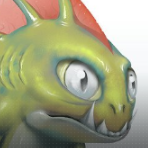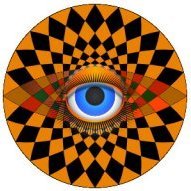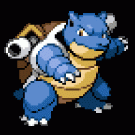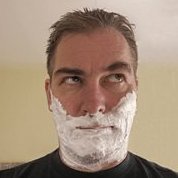
HuniSenpai
-
Posts
114 -
Joined
-
Last visited
Reputation Activity
-
 HuniSenpai reacted to Medical Officer Bones in Artistic Filters?
HuniSenpai reacted to Medical Officer Bones in Artistic Filters?
Download Krita (open source and free). Krita includes the G'MIC filters (over 380 different filters) which include Cut-Out and Brushify artistic filters. Not sure about Palette Knife, but I am sure a similar effect will be possible.
www.krita.org
-
 HuniSenpai got a reaction from Frozen Death Knight in No eyedropper indicator when holding alt
HuniSenpai got a reaction from Frozen Death Knight in No eyedropper indicator when holding alt
I legitimately believe that this kind of change would take maybe 10 to 20 minutes. Now, to be fair, I have never taken on a project of this size before, and I recognize that it may be more difficult than I am assuming. I've done some programming before (Java) with GUI and I know that something seemingly simple can be quite time consuming. However, if it's not too difficult for the devs, I don't see why they can't.
They are making small tweaks in the latest beta version anyways. Things like missing tooltips, improved embedded document bounding boxes, fixed "8/1s" exposure time string, etc.
What i'm saying doesn't need to be changed urgently -- it's alright if it takes a year or two. But I hope that it makes it into a list somewhere of small changes that the AP team will eventually get to after the big problems have been worked out. To be honest, it sounds to me like this tweak will not be taken note of and will never be made. Do you guys have a list somewhere of small tweaks? Unless you can explain why this tweak should not be made, I don't see why it can't make it on to that list.
-
 HuniSenpai reacted to AlexanderEmashev in No eyedropper indicator when holding alt
HuniSenpai reacted to AlexanderEmashev in No eyedropper indicator when holding alt
I agree with the topic starter. Alt + Click with the visible cursor change would be the huge deal especially for the digital artists. Because of the workflow when you select existing colors from the image to paint at the coloring stage. And they do this operation many times per minute. The expected behavior like in other apps for digital drawing would be a big improvement in terms of usability.
-
 HuniSenpai reacted to XzavieR in Your Affinity 2020 wishlist
HuniSenpai reacted to XzavieR in Your Affinity 2020 wishlist
In no particular order:
Bug fixes Develop persona: Batch processing and non-destructive RAW development (sidecar files) Develop persona: Eyedropper for white balance Develop persona: Support for CHDK DNG opcodes / dead pixel interpolation Develop persona: Wider parameter range for adjustments that are limited to 25% or 50% today (saturation, for example) Develop persona: Better support for OnePlus DNG files (currently they always get a green tint and almost no saturation whatsoever - Lightroom handles them correctly in these regards) and other RAW/DNG files that have similar problems in Affinity today Photo persona: Numeric parameters in Curves Photo persona: Eyedroppers for whitepoint, blackpoint and graypoint in Levels and Curves Photo persona: Numeric parameters in auto adjustments (auto color, auto contrast, auto levels etc) Photo persona: Both Fill and Opacity parameters like in Photoshop, especially for "special" blend modes like Hard Mix - and fix the wording in the Layer Effects window that says "Fill opacity" - it's just regular opacity, same as the one in the layers list. Photo and Develop persona: Crop tool extended with "Crop to bounds" and "Crop to opaque" like in Panorama mode Any slider, particularly in Develop and Tonemapping personas: Doubleclick to reset slider to zero/default. -

-

-
 HuniSenpai reacted to Seneca in Destructive Crop
HuniSenpai reacted to Seneca in Destructive Crop
I beg to differ.
Clearly, you are used to destructive cropping, well, get used to the non-destructive cropping.
-
 HuniSenpai reacted to walt.farrell in Destructive Crop
HuniSenpai reacted to walt.farrell in Destructive Crop
Cropping in Affinity Photo has always been non-destructive, and I think it's one of the selling points.
I suppose that Serif could consider implementing a Preference that would defaut to non-destructive, but that you could set to destructive if you wanted to. Or perhaps a setting on the Context Toolbar for the Crop Tool.
-
 HuniSenpai reacted to gleake in Lock brush strokes to Isometric angles
HuniSenpai reacted to gleake in Lock brush strokes to Isometric angles
I would love a feature that would lock brush strokes to Isometric angles, similar to how Procreate does this.
A possible way this would work is:
When the a grid is turned on and the Shift key is being held, align strokes to the grid angles. So if the isometric grid or some other grid is turned on, whatever those angles happen to be, the stroke would lock on to the closest angle of the initial direction.
Happy to provide additional clarification if needed.
Thanks!
-
 HuniSenpai got a reaction from CLC in Replace Color Tool
HuniSenpai got a reaction from CLC in Replace Color Tool
This tool is extremely important for photographers, such as product photographers like myself, who need to select a color and replace it with another, specific, color (throughout the entire image).
At least 6 people on this forum thread are in need of this tool, 7 if you include me
Affinity Photo has a tool for replacing color known as "Color Replacement Brush Tool". However, this tool is not the most useful for some tasks. For instance, what if you want to replace all blue hues in an image with red? Or say you want to adjust the saturation of a specific color in the image (rather than just using HSL, which doesn't let you dial in what specific color you want to affect.. say, for instance, you have an orange color that you want to affect. Or maybe a slightly red-orange color. HSL does not let you target those colors)
I have been responding to questions on this thread right here for some time now, where a user was looking for a tool to replace color. The only solution that we've found is a lengthy workaround that involves select -> select color and then attempting to use HSL to get the desired color. However, it's near impossible to do this method with precision, and it's hard to tell just how the feathering looks when you're doing select -> select sampled color.
This is what people are asking for: a filter or something like that by which you can use an eye dropper (or choose to enter in your own hexadecimal value) as the target. Then, you can change that selected color by using either HSL sliders or by entering in your own hexadecimal value. This is how Photoshop did it (and this was by far one of my favorite features of Photoshop that Affinity Photo lacks):
Relative to the incredibly difficult features that the devs at Affinity Photo implement, I think such a replace color dialog would be rather easy? Half of it is already programmed in the "Select --> select sampled color" tool. The other half would be making that incredibly useful mask preview and adding the color replacement part.
I would be incredibly appreciative if this features was added. I am already a huge fan of Affinity Photo -- I think it does a lot of things better than Photoshop (coming from a person who used Photoshop for 7 years). However, the lack of this tool drives me and others absolutely insane. Thank you for all of your work thus far on Affinity Photo, and thank you for reading through my post!
P.S. No, the color replacement brush tool is not what we need. It's handy in some cases, but for a lot of people, it's a huge hassle compared to Photoshop's "replace color". For others, "replace color" is just about an absolute necessity.
-
 HuniSenpai got a reaction from CLC in 'Replace Colour' - How? (Affinity Photo)
HuniSenpai got a reaction from CLC in 'Replace Colour' - How? (Affinity Photo)
Try using a feather or refine edge.I think you may want to do feather in your case since it's a UI design; use a small feather, like 2px. I assume the problem that your getting (since this is a UI design) is that your cubes and boxes and whatnot have anti-aliasing, which kind of blurs the edges. So maybe try to include those blurry bits in your selection, too.
Are you using flow 100% and opacity 100% on your brush when your painting it in on the layer with the hue blend mode? The hue should change perfectly to whatever color your using.
But yes, this method does not change the lightness; it only really changes the hue. If you wanted to change lightness, too, then make a selection and just start painting, no layer blend mode or anything. Or just use shift + f5 to fill instead of having to use the paint brush. The trick is that your selection has to be really good in that it is softer around the aliased areas by just the right amount. This is really difficult to achieve... you need to find just the right feather amount.
Photoshop's "Replace Color" dialogue would solve all of your issues; it makes the "feathered" selection that you need and then can force the color replacement as you wish. Affinity Photo really needs to add this tool:
You can click on that "result" and it pops up with a color dialogue, where you can paste in your hexadecimal. Affinity Photo does not have "Replace Color" and, as far as I know, neither Photoshop nor Affinity Photo have a brush-tool that preserves lightness like you described. Affinity Photo and Photoshop both have their positives and negatives. One of Affinity Photo's huge negatives (for me and, evidently, for you too) is that they failed to add in the darn "Replace Color" tool. As a product photographer, I really need this Replace Color tool for setting parts of products to particular colors. Hopefully it gets to the devs of Affinity Photo that they really really should add this feature.
-
 HuniSenpai got a reaction from towelhead in Replace Color Tool
HuniSenpai got a reaction from towelhead in Replace Color Tool
This tool is extremely important for photographers, such as product photographers like myself, who need to select a color and replace it with another, specific, color (throughout the entire image).
At least 6 people on this forum thread are in need of this tool, 7 if you include me
Affinity Photo has a tool for replacing color known as "Color Replacement Brush Tool". However, this tool is not the most useful for some tasks. For instance, what if you want to replace all blue hues in an image with red? Or say you want to adjust the saturation of a specific color in the image (rather than just using HSL, which doesn't let you dial in what specific color you want to affect.. say, for instance, you have an orange color that you want to affect. Or maybe a slightly red-orange color. HSL does not let you target those colors)
I have been responding to questions on this thread right here for some time now, where a user was looking for a tool to replace color. The only solution that we've found is a lengthy workaround that involves select -> select color and then attempting to use HSL to get the desired color. However, it's near impossible to do this method with precision, and it's hard to tell just how the feathering looks when you're doing select -> select sampled color.
This is what people are asking for: a filter or something like that by which you can use an eye dropper (or choose to enter in your own hexadecimal value) as the target. Then, you can change that selected color by using either HSL sliders or by entering in your own hexadecimal value. This is how Photoshop did it (and this was by far one of my favorite features of Photoshop that Affinity Photo lacks):
Relative to the incredibly difficult features that the devs at Affinity Photo implement, I think such a replace color dialog would be rather easy? Half of it is already programmed in the "Select --> select sampled color" tool. The other half would be making that incredibly useful mask preview and adding the color replacement part.
I would be incredibly appreciative if this features was added. I am already a huge fan of Affinity Photo -- I think it does a lot of things better than Photoshop (coming from a person who used Photoshop for 7 years). However, the lack of this tool drives me and others absolutely insane. Thank you for all of your work thus far on Affinity Photo, and thank you for reading through my post!
P.S. No, the color replacement brush tool is not what we need. It's handy in some cases, but for a lot of people, it's a huge hassle compared to Photoshop's "replace color". For others, "replace color" is just about an absolute necessity.
-
 HuniSenpai got a reaction from Massi in When using a brush with low hardness, the soft edge extends way beyond the brush preview
HuniSenpai got a reaction from Massi in When using a brush with low hardness, the soft edge extends way beyond the brush preview
Here's a video exemplifying what i'm experiencing, and it's super frustrating when I need to do a shadow by hand, for example:
I'm okay if it extends slightly beyond the brush circle, but this is way too much. I have to hold my brush a couple hundred pixels away from the edge just so it'll land where I want it to.
This doesn't happen if I use a 100% hardness. In fact, the preview circle changes size as I change hardness! The only time where the preview circle size is correct is when the hardness is 100%.
Moreover, the actual size of the circle changes significantly when changing hardness, which I guess is why you're trying to compensate by changing the preview circle (but the preview circle is actually still not quite right). Both of these are at 1817 px size brush, but the one on the left has 0% hardness, and the one on the right has 100%. Look at the size difference (the guides represent the extreme outermost bounds of the layers -- I used Affinity Photo's transform controls to get the actual size, instead of eyeballing it):
I'm guessing this is because i'm just using 8 bits per channel, and, as such, the the steps cut off early?
In short, I want the preview to show the absolute outermost bounds of the brushstroke, not just where its most intense or something strange like that. Is the preview drawing the circle where the brush is 50% alpha or something? I'm not sure.
-
 HuniSenpai got a reaction from Jowday in Replace Color Tool
HuniSenpai got a reaction from Jowday in Replace Color Tool
This tool is extremely important for photographers, such as product photographers like myself, who need to select a color and replace it with another, specific, color (throughout the entire image).
At least 6 people on this forum thread are in need of this tool, 7 if you include me
Affinity Photo has a tool for replacing color known as "Color Replacement Brush Tool". However, this tool is not the most useful for some tasks. For instance, what if you want to replace all blue hues in an image with red? Or say you want to adjust the saturation of a specific color in the image (rather than just using HSL, which doesn't let you dial in what specific color you want to affect.. say, for instance, you have an orange color that you want to affect. Or maybe a slightly red-orange color. HSL does not let you target those colors)
I have been responding to questions on this thread right here for some time now, where a user was looking for a tool to replace color. The only solution that we've found is a lengthy workaround that involves select -> select color and then attempting to use HSL to get the desired color. However, it's near impossible to do this method with precision, and it's hard to tell just how the feathering looks when you're doing select -> select sampled color.
This is what people are asking for: a filter or something like that by which you can use an eye dropper (or choose to enter in your own hexadecimal value) as the target. Then, you can change that selected color by using either HSL sliders or by entering in your own hexadecimal value. This is how Photoshop did it (and this was by far one of my favorite features of Photoshop that Affinity Photo lacks):
Relative to the incredibly difficult features that the devs at Affinity Photo implement, I think such a replace color dialog would be rather easy? Half of it is already programmed in the "Select --> select sampled color" tool. The other half would be making that incredibly useful mask preview and adding the color replacement part.
I would be incredibly appreciative if this features was added. I am already a huge fan of Affinity Photo -- I think it does a lot of things better than Photoshop (coming from a person who used Photoshop for 7 years). However, the lack of this tool drives me and others absolutely insane. Thank you for all of your work thus far on Affinity Photo, and thank you for reading through my post!
P.S. No, the color replacement brush tool is not what we need. It's handy in some cases, but for a lot of people, it's a huge hassle compared to Photoshop's "replace color". For others, "replace color" is just about an absolute necessity.
-
 HuniSenpai got a reaction from Chris B in Issues with Selection Tools
HuniSenpai got a reaction from Chris B in Issues with Selection Tools
I'm not experiencing the same behavior. My guess is that, under the layers panel, you have an adjustment layer selected. An adjustment layer, by default, has a mask that is all white. Thus, the flood selecting is going to select everything. Go to layers (look at the right; change the tab from "Adjustments" to "layers") and select the background layer and try again.
-
 HuniSenpai got a reaction from Fixx in Flip selection?
HuniSenpai got a reaction from Fixx in Flip selection?
Just make your selection, crl + j to put it on a new layer, go to the move tool (v), right click on the selection area, transform -> flip horizontal. Crl + d, then select the new layer and the old layer (hold crl to select more than one) and then crl + shift + e to merge them. This is how I used to do it in Photoshop, I never felt the need for a "flip selection" option. Maybe there was a tool to do this back when I used Photoshop, I just never looked for one.
Oh, and if you don't want the flip to go outside your original selection constraints,do crl + j twice, deselect (crl + d), flip the second duplicate layer, crl + left mouse click on the first duplicate layer's thumbnail, select the second duplicate layer, click the mask button, delete the first duplicate layer, and then merge the second duplicate layer with the original layer with crl + shift + e.
I know this sounds complicated in writing, but, at least to me, it feels pretty natural when i'm doing it in the program, and it takes me maybe 2-5 seconds to do each time. Don't memorize your steps, just understand what each of the steps do any it'll come naturally. If I had to do this constantly then maybe i'd be wanting a specific tool for this, but i've never felt the need.
-
 HuniSenpai reacted to R C-R in af Photo NOT precise
HuniSenpai reacted to R C-R in af Photo NOT precise
As has already been discussed in great detail, in general for things like this you should enable "Force Pixel Alignment" (the left button) but not "Move By Whole Pixels (the right button) because the latter will move objects that currently are not aligned on whole pixel boundaries by whole pixel values. IOW, if something is currently at an x value of 10.5 px, with MBWP enabled a will move to 11.5, 9.5, etc. values, preserving the fractional pixel part of the x value.
This is not an issue if you start with both options enabled before creating anything in a new document, this won't be an issue bur for existing documents you should be aware of the difference.
It is not destructive unless you rasterize the layer, but as for it being a standard setting these buttons are "sticky" (as are all the snapping options) meaning that once set they won't change if you open another existing or new document.
-
 HuniSenpai got a reaction from firstdefence in Emboss effect fix?
HuniSenpai got a reaction from firstdefence in Emboss effect fix?
Method 1: Time consuming but high quality result
Here's a time consuming yet highly effective fix that I came up with. But it takes time and requires you to rasterize the layer (annoying if you need to change the text later):
Method 2: Quicker but far lower quality
If you want a quick fix then you can duplicate the rasterized beveled text, and then apply a blur to that. Then, with the blurred layer selected, click the gear icon at the top right of the layer panel. This will pop up a window. Place a point on the "underlying composition ranges" graph that is equal to the lightness value of your text color (my text was 33%, for example. Double click on color bubble and look at "L" in HSL section). Then drag that point down all the way. Then bring everything else back up on the graph. Then bring white down all the way (this only works on a white background btw). Graph should have a valley at pure white and at the lightness of your actual text face. Should look something like this:
The problem is that the first blur step that you do is accidentally getting some of the front face (since you're not doing any selecting) and it makes the effect not quite as sharp:
Here's how it looks if you use method 1:
And here's how it looks if you don't do anything:
-
 HuniSenpai got a reaction from NobleValerian in 'Replace Colour' - How? (Affinity Photo)
HuniSenpai got a reaction from NobleValerian in 'Replace Colour' - How? (Affinity Photo)
Try using a feather or refine edge.I think you may want to do feather in your case since it's a UI design; use a small feather, like 2px. I assume the problem that your getting (since this is a UI design) is that your cubes and boxes and whatnot have anti-aliasing, which kind of blurs the edges. So maybe try to include those blurry bits in your selection, too.
Are you using flow 100% and opacity 100% on your brush when your painting it in on the layer with the hue blend mode? The hue should change perfectly to whatever color your using.
But yes, this method does not change the lightness; it only really changes the hue. If you wanted to change lightness, too, then make a selection and just start painting, no layer blend mode or anything. Or just use shift + f5 to fill instead of having to use the paint brush. The trick is that your selection has to be really good in that it is softer around the aliased areas by just the right amount. This is really difficult to achieve... you need to find just the right feather amount.
Photoshop's "Replace Color" dialogue would solve all of your issues; it makes the "feathered" selection that you need and then can force the color replacement as you wish. Affinity Photo really needs to add this tool:
You can click on that "result" and it pops up with a color dialogue, where you can paste in your hexadecimal. Affinity Photo does not have "Replace Color" and, as far as I know, neither Photoshop nor Affinity Photo have a brush-tool that preserves lightness like you described. Affinity Photo and Photoshop both have their positives and negatives. One of Affinity Photo's huge negatives (for me and, evidently, for you too) is that they failed to add in the darn "Replace Color" tool. As a product photographer, I really need this Replace Color tool for setting parts of products to particular colors. Hopefully it gets to the devs of Affinity Photo that they really really should add this feature.
-
 HuniSenpai got a reaction from Dan C in White Balance in Affinity Photo 1.7.0.367 Doesn't Adjust Tint?
HuniSenpai got a reaction from Dan C in White Balance in Affinity Photo 1.7.0.367 Doesn't Adjust Tint?
Thanks for the reply :)! Love the program btw. It's got a few glitches but I do really appreciate the work that you and others at Serif do-- this program has saved me a lot of money over that one product from that one company beginning with A and ending with "we're going to steal your money with a monthly subscription now" lol!
-
 HuniSenpai got a reaction from velarde in Please Save My Settings for Lasso Tool and Refine Edge (& other tools)
HuniSenpai got a reaction from velarde in Please Save My Settings for Lasso Tool and Refine Edge (& other tools)
Every time I open up a new photo in Affinity Photo, some things are saved, and some things aren't. Quick select, for instance, continues to have the same width as on the previous document. Same for brush tool.
But I really, really wish the lasso tool and the refine edge menu would save settings. This means that, if I used polygon lasso tool on add mode with a 2px feather in the previous document, I want that to be the same in the next document.
Perhaps even more importantly, refine edge should have a checkbox for "remember these settings." When I'm doing product photography for an Amazon listing, I want the refine edge to look the same on all of the images. Right now, in order to do that, I need to either memorize what settings I used or take a screenshot. That one program that starts with a P had a checkbox for "remember these settings" on the refine edge, and it was a life saver.
There's a good chance that there's some logical reasoning why things are the way they are, but these are just my thoughts. Thank you so much :)!
Edit: also, btw, when you finish making a selection and you have some feather turned on, can you separate out the "set current raster selection" and then "feather applied" when the person finally double clicks to make selection? I know it seems strange thing, but this is actually a pretty big deal. I don't know about other people, but I've lost 15 minutes of careful lasso selection all because, after finishing the selection, I realize I've had feather turned on, and there's no way to undo just the feather part. This is something that annoyed me both in this program and in that other Ph***sho* program.
-
 HuniSenpai got a reaction from Jörn Reppenhagen in Loving New and Improved HSL Adjustment in 1.7.0.243, But I Have Suggestions
HuniSenpai got a reaction from Jörn Reppenhagen in Loving New and Improved HSL Adjustment in 1.7.0.243, But I Have Suggestions
Hello! I recently downloaded the latest beta and it is truly amazing. Huge performance improvements, the addition of things that were missing before (like being able to negatively adjust the blackpoint in levels adjustment) and there are some neat new improvements to the HSL adjustments, where you can now pick a specific color and adjust its hue / saturation / luminosity. Cool.
However:
The picker should not be grayed out by default. Why do I need to select a color first, before I can select the picker? Here's my more important suggestion: add plus and minus color pickers in addition to the standard picker. Take a look at how it's done in Davinci Resolve. Here's how I think it would work behind the scenes: Firstly, let it be assumed that the picker would now not only select hue, but also would select by saturation and luminosity. It would function like the magic wand tool. On its own, this would suck. But read on. Now, add a + and - picker. With the + picker, you can click and drag to add to the selection. If you make a mistake, use the - picker to remove from that. Maybe add a "fuzziness" slider, too, to make the selection less harsh. This is how I imagine it would look like (ignore all of the nodes and stuff that Davinci Resolve does, of course; just look at the + and - color pickers in the color selection panel) -
 HuniSenpai got a reaction from Frozen Death Knight in Loving New and Improved HSL Adjustment in 1.7.0.243, But I Have Suggestions
HuniSenpai got a reaction from Frozen Death Knight in Loving New and Improved HSL Adjustment in 1.7.0.243, But I Have Suggestions
Hello! I recently downloaded the latest beta and it is truly amazing. Huge performance improvements, the addition of things that were missing before (like being able to negatively adjust the blackpoint in levels adjustment) and there are some neat new improvements to the HSL adjustments, where you can now pick a specific color and adjust its hue / saturation / luminosity. Cool.
However:
The picker should not be grayed out by default. Why do I need to select a color first, before I can select the picker? Here's my more important suggestion: add plus and minus color pickers in addition to the standard picker. Take a look at how it's done in Davinci Resolve. Here's how I think it would work behind the scenes: Firstly, let it be assumed that the picker would now not only select hue, but also would select by saturation and luminosity. It would function like the magic wand tool. On its own, this would suck. But read on. Now, add a + and - picker. With the + picker, you can click and drag to add to the selection. If you make a mistake, use the - picker to remove from that. Maybe add a "fuzziness" slider, too, to make the selection less harsh. This is how I imagine it would look like (ignore all of the nodes and stuff that Davinci Resolve does, of course; just look at the + and - color pickers in the color selection panel) -
 HuniSenpai got a reaction from TEcHNOpls in Loving New and Improved HSL Adjustment in 1.7.0.243, But I Have Suggestions
HuniSenpai got a reaction from TEcHNOpls in Loving New and Improved HSL Adjustment in 1.7.0.243, But I Have Suggestions
Hello! I recently downloaded the latest beta and it is truly amazing. Huge performance improvements, the addition of things that were missing before (like being able to negatively adjust the blackpoint in levels adjustment) and there are some neat new improvements to the HSL adjustments, where you can now pick a specific color and adjust its hue / saturation / luminosity. Cool.
However:
The picker should not be grayed out by default. Why do I need to select a color first, before I can select the picker? Here's my more important suggestion: add plus and minus color pickers in addition to the standard picker. Take a look at how it's done in Davinci Resolve. Here's how I think it would work behind the scenes: Firstly, let it be assumed that the picker would now not only select hue, but also would select by saturation and luminosity. It would function like the magic wand tool. On its own, this would suck. But read on. Now, add a + and - picker. With the + picker, you can click and drag to add to the selection. If you make a mistake, use the - picker to remove from that. Maybe add a "fuzziness" slider, too, to make the selection less harsh. This is how I imagine it would look like (ignore all of the nodes and stuff that Davinci Resolve does, of course; just look at the + and - color pickers in the color selection panel) -
 HuniSenpai got a reaction from jc4d in Loving New and Improved HSL Adjustment in 1.7.0.243, But I Have Suggestions
HuniSenpai got a reaction from jc4d in Loving New and Improved HSL Adjustment in 1.7.0.243, But I Have Suggestions
Hello! I recently downloaded the latest beta and it is truly amazing. Huge performance improvements, the addition of things that were missing before (like being able to negatively adjust the blackpoint in levels adjustment) and there are some neat new improvements to the HSL adjustments, where you can now pick a specific color and adjust its hue / saturation / luminosity. Cool.
However:
The picker should not be grayed out by default. Why do I need to select a color first, before I can select the picker? Here's my more important suggestion: add plus and minus color pickers in addition to the standard picker. Take a look at how it's done in Davinci Resolve. Here's how I think it would work behind the scenes: Firstly, let it be assumed that the picker would now not only select hue, but also would select by saturation and luminosity. It would function like the magic wand tool. On its own, this would suck. But read on. Now, add a + and - picker. With the + picker, you can click and drag to add to the selection. If you make a mistake, use the - picker to remove from that. Maybe add a "fuzziness" slider, too, to make the selection less harsh. This is how I imagine it would look like (ignore all of the nodes and stuff that Davinci Resolve does, of course; just look at the + and - color pickers in the color selection panel)









